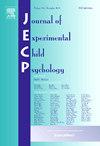Children’s evaluations of direct and indirect bias justifications for same-race inclusion
IF 1.8
2区 心理学
Q3 PSYCHOLOGY, DEVELOPMENTAL
引用次数: 0
Abstract
Different forms of prejudice emerge in childhood, often referred to as direct and indirect bias. Little is known about children’s evaluations of whether certain forms of bias are more okay than others, particularly in the context of peer and parental messages about interracial social inclusion. To address this gap, the current study investigated how Black and White American children aged 6 to 12 years (N = 219; Mage = 9.18 years, SD = 1.90; 51% female) evaluate vignettes in which a Black or White peer opted to include a same-race peer due to indirect bias (preferences for in-group similarity) or direct bias (expressions of out-group dislike). Data were collected in 2021 and 2022. Children evaluated same-race inclusion due to expressions of out-group dislike more negatively than same-race inclusion due to in-group similarity preference. They also evaluated same-race inclusion due to a preference for in-group similarity stated by peers more negatively than when stated by parents. Children evaluated same-race inclusion due to parental preference more positively when the child who included a same-race peer was Black than when the child who included a same-race peer was White. Participants who negatively evaluated same-race inclusion due to parental preference were more likely to use moral reasoning to justify their evaluations, whereas participants who positively evaluated this inclusion were more likely to use non-moral reasoning. This study revealed novel insights about how Black and White American children evaluate forms of direct and indirect bias as justifications for same-race inclusion and how their reasoning relates to their evaluations.
求助全文
约1分钟内获得全文
求助全文
来源期刊

Journal of Experimental Child Psychology
Multiple-
CiteScore
4.50
自引率
7.70%
发文量
190
期刊介绍:
The Journal of Experimental Child Psychology is an excellent source of information concerning all aspects of the development of children. It includes empirical psychological research on cognitive, social/emotional, and physical development. In addition, the journal periodically publishes Special Topic issues.
 求助内容:
求助内容: 应助结果提醒方式:
应助结果提醒方式:


